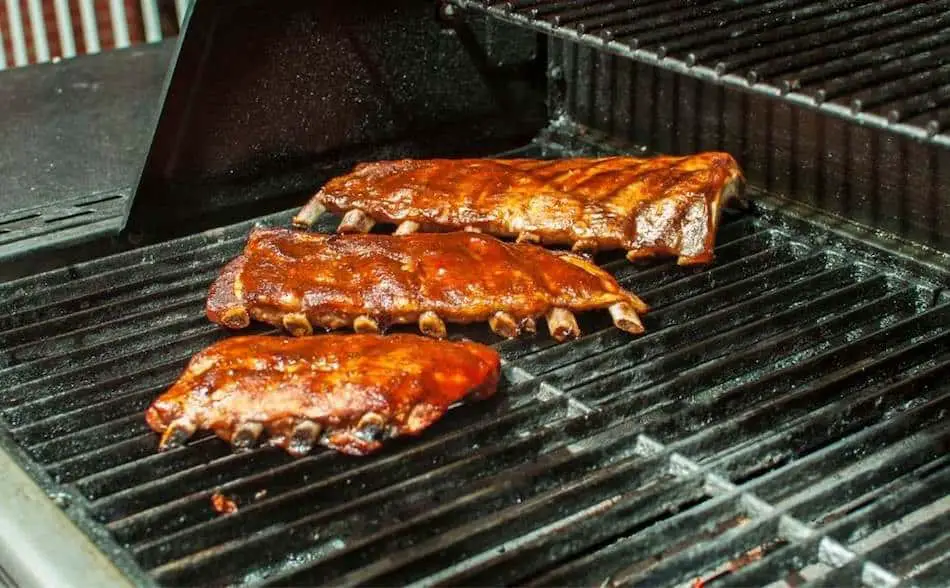
Timing is important when wrapping smoked ribs. If you wrap too soon, you won’t get a nice bark, or as much smoke flavor. If you wrap the ribs too late, you may end up with a dry or charred rib rack. But knowing when to wrap can be a be confusing. Should you go by temperature, time, or look and feel? I wanted to find out the answers to these questions, so I asked the barbecue gurus these questions and many more.
Wrapping ribs during the smoking process can help to lock in moisture and create a tender, fall-off-the-bone texture. While the internal temperature of the ribs should be around 150° F or higher by the time they are ready to be wrapped, experienced pitmasters often wrap their ribs based on the color of the meat rather than temperature or an exact time. This technique takes practice, but is generally preferred to wrapping ribs by time or temperature. Before wrapping, ribs should have a nice mahogany color and possibly some charring on the bones if they have been rotated evenly.
“There is no one ‘right’ way to smoke ribs, but in general, the key is to keep the temperature low and cook them slowly.”
– Chris Lilly, executive chef at Big Bob Gibson Bar-B-Q
“Unwrapped Ribs – The Pros and Cons ( Plus A No Wrap Rib Recipe)”
What the BBQ Experts Say
When it comes to smoking ribs, barbecue pitmasters and experts have a variety of opinions on the best techniques and methods. Chris Lilly, executive chef at Big Bob Gibson Bar-B-Q, emphasizes the importance of keeping the temperature low and cooking ribs slowly. “There is no one ‘right’ way to smoke ribs,” he says, “but in general, the key is to keep the temperature low and cook them slowly.”
One controversial topic among pitmasters is the use of foil when smoking ribs. Myron Mixon, owner of Jack’s Old South BBQ, likes to wrap his ribs after about 4-5 hours of smoking. “This helps to lock in moisture and create a tender, fall-off-the-bone texture,” he says. Moe Cason, owner of Ponderosa BBQ, takes a different approach and never wraps his ribs. “I think it’s a shortcut and it doesn’t add any real flavor,” he says. “Instead, I like to baste my ribs with a mixture of apple cider vinegar, brown sugar, and spices to add moisture and depth of flavor.”
“Wrapping ribs in foil is a controversial topic in the barbecue world, but I personally like to wrap my ribs after about 4-5 hours of smoking. This helps to lock in moisture and create a tender, fall-off-the-bone texture.”
– Myron Mixon, BBQ pitmaster and owner of Jack’s Old South BBQ
Tuffy Stone, owner of Cool Smoke BBQ, suggests using the “3-2-1 method” as a starting point for smoking ribs – 3 hours of smoking, 2 hours wrapped in foil, and 1 hour unwrapped to crisp up the bark. However, he adds that “every cut of meat is different and you have to pay attention to your pit and adjust accordingly.” Aaron Franklin, owner of Franklin Barbecue, also warns against wrapping ribs too tightly or for too long, as it can result in steaming the meat instead of smoking it.
Melissa Cookston, owner of Memphis BBQ Co., likes to add a sweet and savory twist to her foil-wrapped ribs by slathering them with a mixture of butter, brown sugar, and honey before wrapping them up. Rodney Scott, owner of Rodney Scott’s BBQ, also wraps his ribs in foil, but adds apple juice to the foil package for extra moisture and sweetness, along with a few sprigs of rosemary for a subtle herbal flavor.
“I never wrap my ribs. I think it’s a shortcut and it doesn’t add any real flavor. Instead, I like to baste my ribs with a mixture of apple cider vinegar, brown sugar, and spices to add moisture and depth of flavor.”
– Moe Cason, BBQ pitmaster and owner of Ponderosa BBQ
On the other hand, Johnny Trigg, owner of Smokin’ Triggers BBQ, never wraps his ribs. He believes that the key to great ribs is patience and smokes his ribs low and slow for at least 8 hours, basting them every hour or so with a mixture of apple cider vinegar and his secret spice blend. Eddie Jackson, owner of Eddie Jackson’s BBQ, shares a similar approach, saying that he never wraps his ribs and prefers to smoke them low and slow for at least 8 hours.
Franklin Becker, owner of Becker’s BBQ, combines the use of foil with BBQ sauce to create tender, juicy ribs with a perfect balance of smoke and sauce. “I wrap my ribs in foil, but I also add a few tablespoons of my favorite BBQ sauce and a splash of apple juice to the foil package,” he says.
“Some pitmasters swear by the ‘3-2-1 method’ for smoking ribs – 3 hours of smoking, 2 hours wrapped in foil, and 1 hour unwrapped to crisp up the bark. I think it’s a good starting point, but every cut of meat is different and you have to pay attention to your pit and adjust accordingly.”
– Tuffy Stone, BBQ pitmaster and owner of Cool Smoke BBQ
Overall, the decision to wrap ribs in foil or not is a matter of personal preference and depends on the desired texture and flavor of the finished product. Whether you prefer to baste your ribs with a mixture of spices and vinegar, slather them with sweet and savory sauces, or add herbs and fruit juice to the foil package, there are many different techniques and approaches to consider when smoking ribs.
“How To Reheat Ribs – The Best Way To Restore Leftover Barbecue”
Wrap By Look, Not By Time or Temperature
Experienced Pitmasters wrap their ribs, judging by the look rather than temperature or an exact time. This takes time and practise, but once you have smoked a few racks, you will know what to look for. If you are uncomfortable, and don’t know what to look for, then it’s fine to measure the internal temperature of the ribs. A better way would be to wrap the ribs by time rather than temperature. If you are smoking between 225° F and 275° F, it would be safe to wrap 2 hours to 2.5 hours into the cook.
What Should The Ribs Look Like Before Being Wrapped?
Once the ribs have been sitting on the grill for about 2 or 2.5 hours, they will have developed a nice mahogany color. If you’ve been using a nice cherry wood mixed in with hickory, the cherry will give you some extra color. You may also notice some charring on some bones, but hopefully you’ve been rotating the ribs, so they have cooked evenly.
“I always wrap my ribs in foil, but I like to add a little something extra to the foil package. I mix together equal parts butter, brown sugar, and honey, and then slather it all over the ribs before wrapping them up. The result is a sweet and savory rib that just falls off the bone.”
– Melissa Cookston, BBQ pitmaster and owner of Memphis BBQ Co.
When Does Aaron Franklin Wrap Ribs?
I’ve watched Aaron Franklin smoke ribs several times, and he normally wraps about 2 hours into the cook. When Aaron smokes ribs at 275° F, he’s usually happy with the color of the ribs at the 2-hour mark. Then he will spritz and sauce the ribs before wrapping in 2 layers of thick foil.
“Wrapping ribs in foil can definitely speed up the cooking process, but be careful not to wrap them too tightly or for too long, or you’ll risk steaming the meat instead of smoking it.”
– Aaron Franklin, BBQ pitmaster and owner of Franklin Barbecue
Have you tried smoking a Wagyu brisket yet? You can get one delivered to your door from Snake River Farms.
When Does Malcolm Reed Wrap Ribs?
BBQ Guru Malcolm Reed wraps his pork spare ribs at around the 2-hour mark. He usually starts checking the ribs 1 hour and 45 minutes into the cook. Malcolm also prefers to go by color rather than temperature when deciding to wrap. He’s looking for a nice mahogany color on the ribs before foiling. When I’ve seen Malcolm smoking ribs, he sets his smoker to around about 235° F. Malcolm uses two layers of foil to wrap his ribs, and usually likes to make a boat with the foil, and sauces the ribs before going back into the smoker.
Did you know there’s now a meat thermometer with no wires that can control with your phone? Check out MEATER
Spritz Before Wrapping
As the ribs are getting close to wrapping stage, it’s a good idea to spritz the ribs prior to wrapping. Not only will this prevent the ribs from drying out, but it will also prepare the ribs for the sauce. The best spritz for ribs is apple juice or apple cider vinegar.
“Wrapping ribs in foil is a personal preference, but I think it’s important to let the ribs smoke for at least the first half of the cook. That’s when they’ll pick up the most flavor from the wood and smoke.”
– Rodney Scott, BBQ pitmaster and owner of Rodney Scott’s BBQ
Sauce Before Wrapping
Applying a barbecue sauce is an important step in smoking ribs. Once the ribs have reached wrapping stage, a common technique is to baste the ribs with your favorite barbecue sauce. Aaron Franklin will heat his barbecue sauce before basting the ribs. He believes the source will become too gloopy.
Aaron will also spritz the sauce onto the ribs after he has basted. I have tried this method and believe it is the best way. I prefer using a barbecue sauce in a squirt bottle rather than using a basting brush.
This method protects the bark. We work so hard to develop that nice crispy crust on the outer layer of the meat, so I don’t want to brush any of it off. So by squirting the ribs with barbecue sauce, and gently spritzing should spread the sauce out evenly, without damaging your bark.
“I think wrapping ribs in foil is a great way to lock in moisture, but I like to do it a little differently. I wrap my ribs in foil, but I also add a few tablespoons of my favorite BBQ sauce and a splash of apple juice to the foil package. The result is a tender, juicy rib with a perfect balance of smoke and sauce.”
– Franklin Becker, BBQ pitmaster and owner of Becker’s BBQ
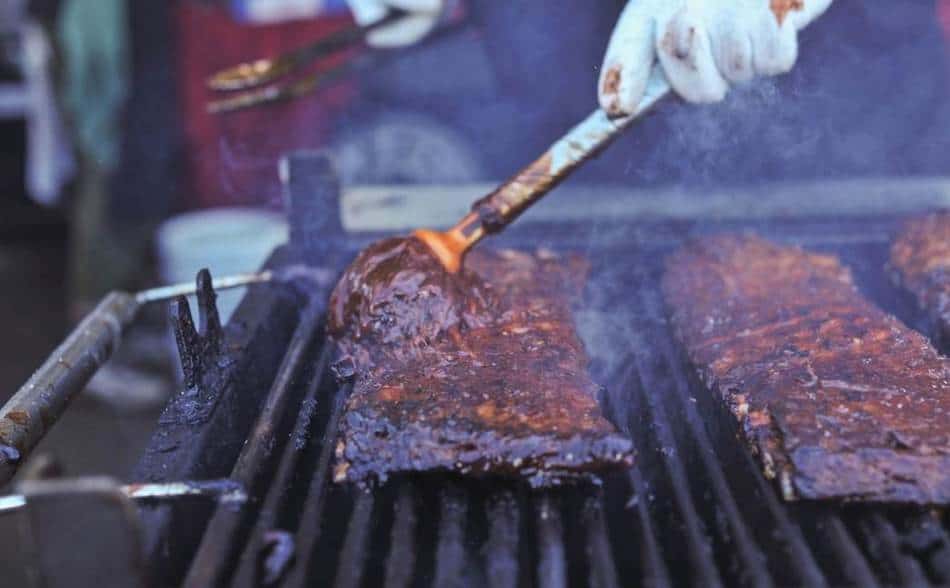
How to Wrap Ribs
Most pitmasters wrap their ribs in aluminium foil rather than butcher paper. Use two layers of heavy duty foil and make sure that the bones are not sticking out. This is very important for smoking ribs, because if any of the bones pierce the foil, it’s going to cause a leak, and slow down the cooking because he will escape. When wrapping the ribs, fold the corners neatly so that you can access the ribs while on the smoker. If you just scrunch up the foil tightly, you will not be able to access the ribs to check for tenderness or apply more sauce.
“I always wrap my ribs in foil, but I like to add a little apple juice to the foil package to add some extra moisture and sweetness. I also throw in a few sprigs of rosemary for a subtle herbal flavor.”
– Johnny Trigg, BBQ pitmaster and owner of Smokin’ Triggers BBQ
How Long Do You Leave Ribs in Foil?
A common way of smoking ribs is using what is called a 2-2-1 method. This involves smoking the ribs for 2 hours uncovered, then 2 hours wrapped. Then, 1 hour in a sauce. The 2-2-1 differs from the 3-2-1 method, which involves cooking the ribs for 3 hours unwrapped, 2 hours wrapped, and 1 hour unwrapped with a sauce. Although these methods are popular, they are not ideal for smoking ribs and they aren’t practised among the pros. Those methods provide a good framework, but they can overcook ribs. The best way is to smoke the ribs for 2 hours unwrapped, and then 2 hours wrapped in foil and sauce, and then test for tenderness.
“I never wrap my ribs. I think the key to great ribs is patience. I like to smoke my ribs low and slow for at least 8 hours, basting them every hour or so with a mixture of apple cider vinegar and my secret spice blend.”
– Eddie Jackson, BBQ pitmaster and owner of Eddie Jackson’s BBQ
When Are Ribs Done?
There are several ways to tell when the ribs have reached the perfect tenderness. Temperature is an excellent guide, but it’s not ideal. Once ribs have reached ideal tenderness, the internal meat temperature should be around about 200°F. However, most pitmasters will perform a tenderness test to determine whether the ribs have reached perfect tenderness. A tenderness test involves bending the ribs or twisting a bone. You don’t want to overcook ribs; you want them tender but not fall off the bone tender. Part of the enjoyment of eating ribs is chewing the meat off the bone. When performing the band’s test, slightly bend the ribs, and look for the meat cracking slightly. This is a sign that it is done.
You should be able to twist the bone and feel as though you could pull it off the meat. You can also take a toothpick and poke the meaty part of the ribs in the middle. It should feel as though you are poking a stick of butter if you have achieved perfect tenderness. You can also feel this when inserting an instant-read thermometer. When you insert the probe, it should feel as though there is no resistance. These are all signs that you have nailed your ribs.
World Brisket Champion Harry Soo is now sharing his secrets with his Competition Meat Rubs.
Rest Your Ribs
Once you have removed your ribs from the smoker, allow some time for the moisture to reabsorb. Vent the ribs a little by opening the foil to let out some of the steam. The ideal resting time is anywhere between 30 minutes and 1 hour.
Wrapping Ribs in Butcher Paper
Butcher paper is extremely popular for smoking brisket. When compared to foil, paper has been found to preserve the bark much better because it allows the meat to breathe. Foil traps the steam and makes the bark soggy. However, foil seems to be more popular for smoking ribs. I rarely see pitmasters using paper, although paper is suitable.
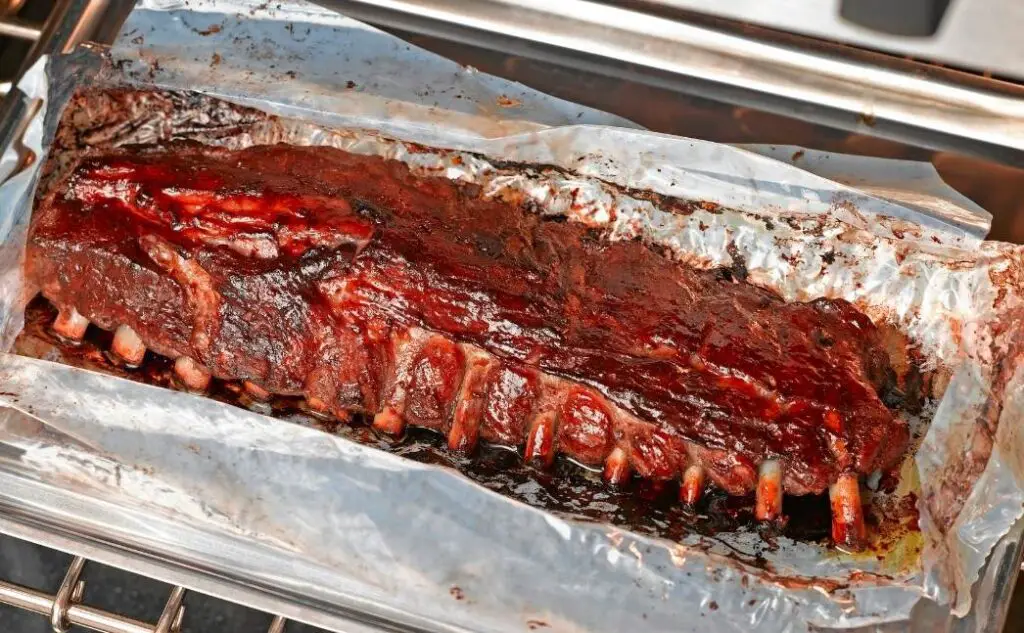
The Best Sauce for Ribs
You can use any type of barbecue sauce for smoking ribs. Some people mix water to thin the sauce a little. To do this, place the source in a squirt bottle, and feel half with water and half with sauce. Most barbecue sauces will have a lot of sugar. As you would be aware, sugar will burn easily, so keep this in mind when applying the sauce. It’s ok to leave the ribs on the grill unwrapped while the sauce is setting, but don’t leave it unwrapped any longer than about 15 minutes. The safest way is to sauce the ribs and leave it in the aluminium foil to prevent the sauce from burning.
“When To Sauce Ribs? We Asked The Pitmasters”
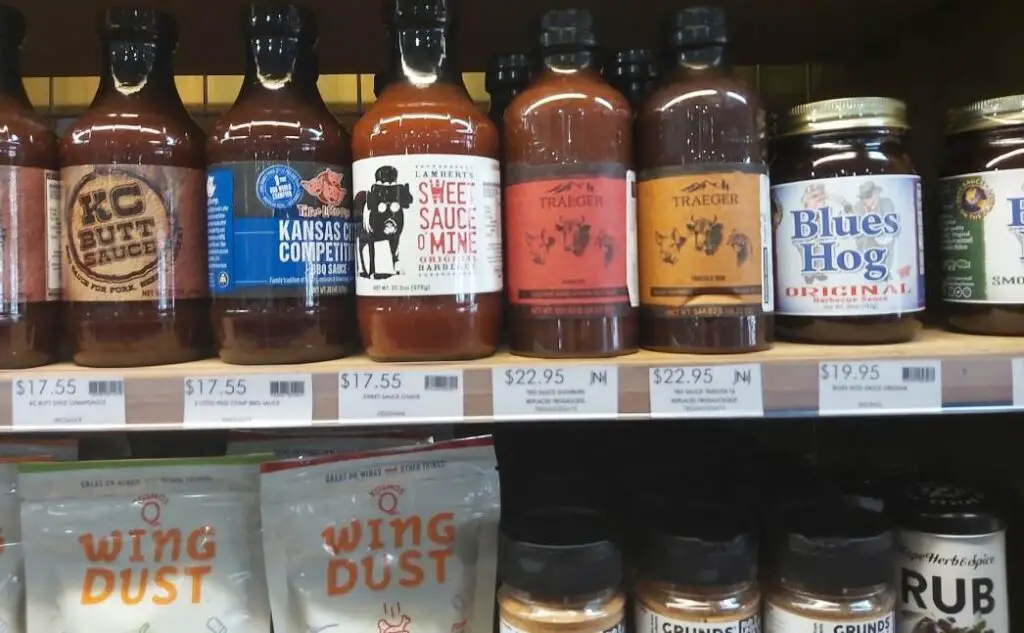
Brining Ribs
Apply a layer of salt and pepper prior to adding the barbecue rub. Give the salt about 2 hours to penetrate the meat. The salt will draw out some of the moisture from the meat and will help the rub stick to the surface.
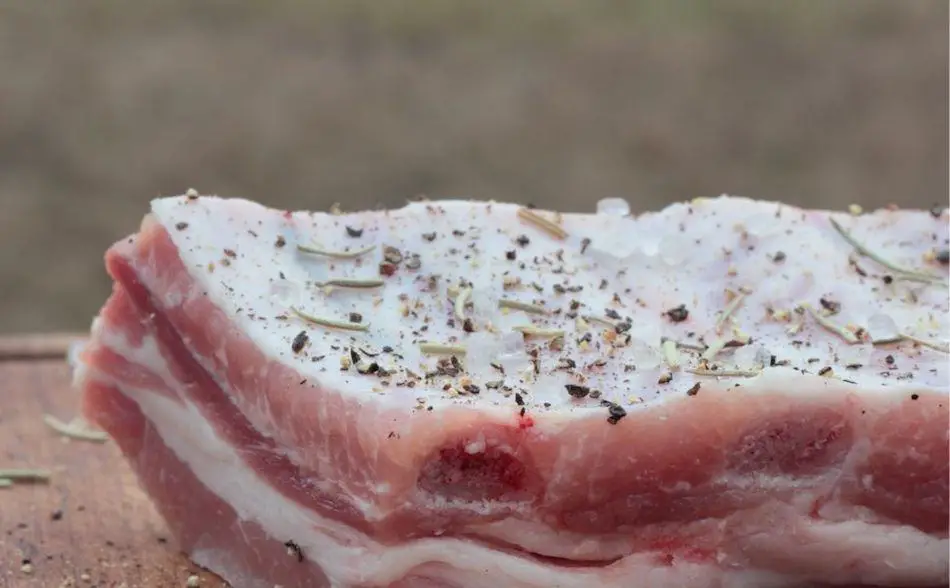
Rubs and Binder
Most Pit Masters will apply some type of binder to the ribs before applying the barbecue rub. You can use olive oil or yellow mustard as a binder, and it won’t influence the flavor.
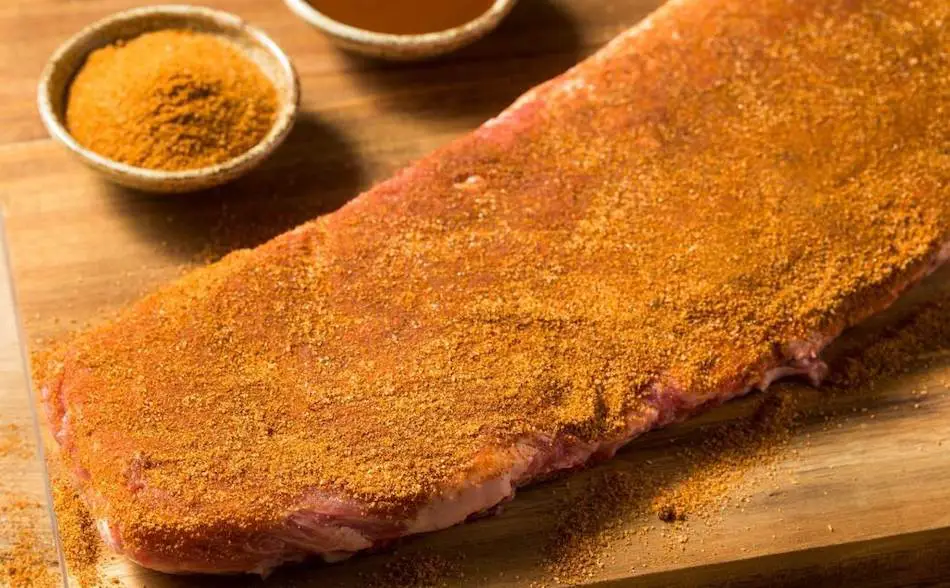
Standard Barbecue Rub

I found this great rub recipe through How To BBQ Right. I use this recipe and alter it slightly depending on what I'm cooking. Made by the guys at Townsend Spice & Supply: https://townsendspice.com/
Ingredients
- - ½ Cup Paprika
- - ½ Cup Salt
- - ½ Cup Sugar
- - ½ Cup Granulated Garlic
- - ¼ Cup Granulated Onion
- - ¼ Cup Chili
- - ¼ Cup Cumin
- - 2 Tablespoons Black Pepper
- - 2 Tablespoons Dry Mustard
- - 1 Tablespoon Cayenne Pepper
Instructions
- Combine all the spices together in a large mixing bowl
- Store rub in rub shakers
My Favorite Meat Smoking Tools
Thanks for checking out this article. I hope you learned a few things. Here are some of my favorite tools I use when smoking brisket that may be useful to you. These are affiliate links, so if you decide to purchase any of these products, I’ll earn a commission. But in all honesty, these are the tools I recommend to my family and friends who are just starting out.
Meat Thermometer: There are dozens of fancy thermometers on the market, but I still use my trusty TP20. For around $50, I have a high-quality meat thermometer with two probes, and can track the temperature of my smoker with one probe, and my meat with the other probe. The ThermoPro TP20 is an Amazon Best Seller because it’s the easiest thermometer to operate, is durable, highly accurate, and comes with pre-programmed meat settings.
Instant Read Thermometer: Arguably, the second most important tool you need is a fast and accurate instant-read thermometer. These tools play an important role in the latter stages of the cook when the meat needs regular checking in multiple areas. I use the ThermoPro TP19 because it can do everything a ThermaPen can do, but for a fraction of the cost. You can check out the TP19 on Amazon here.
Wireless Thermometer: The latest thermometers on the market have no wires and can be controlled by wi-fi via your phone. Airprobe 3 is the best of this technology.
Butcher Paper: Wrapping brisket in butcher paper has become a huge trend in barbeque thanks to Aaron Franklin. Wrapping your brisket in paper will give you a nice brisket bark. However, you can’t just use any old paper, it has to be unwaxed, food grade paper. You can find it on Amazon here.
Advanced Thermometer and Automatic Temperature Controller: Once you’re ready to take things seriously, the FireBoard 2 Drive is a six-channel Bluetooth/Wi-Fi thermometer that can monitor up to 6 pieces of meat, control and graph your cook sessions on your smartphone, and attaches to an an automatic blower that will convert your charcoal smoker to a set-and-forget. This is one of the most advanced meat thermometers on the market. You can check it out on the FireBoard website here.
